As the night draws in and the daylight diminishes, your hunt for sustenance takes you to Taipei’s famous Shilin Night Market. As you draw close to the famed food haunt, its bright lights punctuate the dark Taiwanese night. Getting out of your taxi, you are bombarded with a cacophony of smells. Some are alluring, while others are not quite so pleasing to your senses. Wandering the packed streets, head spinning, you fill your belly with various fried morsels. The whirlwind takes you past a frog egg jelly drink stall and you slurp down a cup of the refreshing lemony concoction. Feeling invigorated, your excursion brings you to a dark building highlighted by dim red aura emanating from lanterns within. This is the Shihlin Chi Hsien Chou (慈諴宮 Shìlín Cíxián Gōng), known to foreign visitors simply as Cixian Temple.
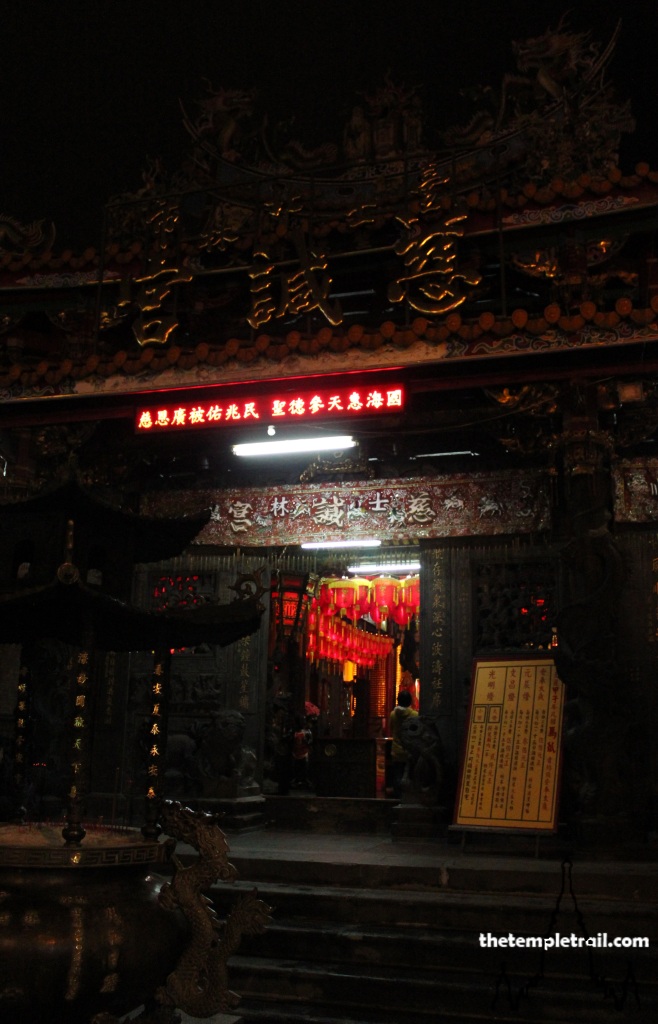
The street in front of the temple is filled with food carts, but obscured slightly are three structures on the opposite side from the temple. These pavilions are the Phoenix Pavilion (鳳閣 Fèng Gé), Dragon Pavilion (龍亭 Lóng Tíng) and Vow Devotion Pavilion (效忠閣 Xiào Zhōng Gé). They are open hexagonal platforms that can be used for resting and staging performances during festivals. As they are hidden from full view, you are just able to make out parts of their ornate eaves in the gloom. The Dragon Kings of the Four Seas (四海龍王 Sìhǎi Lóng Wáng), the Eight Immortals (八仙 Bāxiān) and the Heavenly Kings (天王 Tiān Wáng) all look out from under the curved roofs of the pavilions.
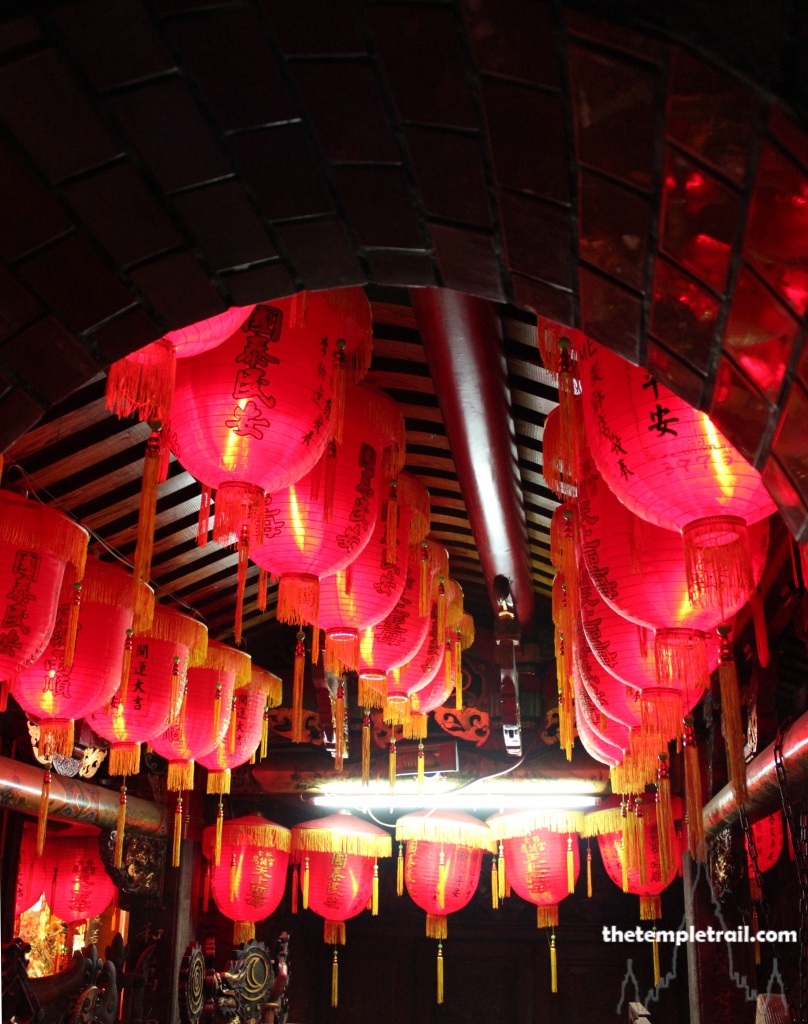
Turing to face the main building, you a granted a clearer view of the main temple building, constructed by two rival groups of Chinese artisans from the mainland, who saw the temple as a way of competing against each other. Originally called Tiān Hòu Temple, it is dedicated to Māzǔ (媽祖), the sea goddess. The first temple was built in 1796 by a wealthy merchant called He Chin Tang. The temple was subsequently burnt down during a clan war between rival groups from Zhangzhou and Quanzhou. A local noble called Pan Yung Ching ensured the reconstruction of the whole area and the temple and much of what you see before you dates from between 1864 and the various additions and reconstructions up to 1927. Built in the Fujian style, the temple is made of a series of halls, galleries and wings that form five courtyards. It is a mother temple to which other god images are brought to restore their powers. Stepping up to the doors of the temple and viewing the swallowtails of the roof, you hope that the temple restores your powers also.

The main doors are flanked by a pair of lions, as well as a pair of Chinese unicorns (麒麟 qílín). The panels of the qílín date from 1828 and touching them, you try to gain some luck. The dragon columns that mark the main entrance are from the late 18th century and standing at the entrance among these carvings, you are transported to a mythical land of fantastic creatures. The door gods who protect the entrance into the foyer of the double-eaved gable and hip roofed Three Rivers Hall (三川殿 Sān Chuān Diàn) are realistically rendered and you can almost imagine them bursting out of the woodwork. The main door gods here are Qín Shūbao (秦叔寶) and Yùchí Gōng (尉遲恭), Tang Dynasty (618 – 907 CE) generals. During the reign of the Taizong Emperor (唐太宗 Táng Tàizōng) a drought caused the emperor to execute the Dragon King for allowing the rivers to dry up. The ghost of the Dragon King haunted the emperor in his sleep so he appointed Generals Qín Shūbao and Yùchí Gōng to guard his door at night and prevent the ghost from entering his bedchamber. From that point on, Chinese people have used portraits of the two generals on doors to protect those inside. Saluting the martial guardians, you dip your head and cross the threshold into the temple.
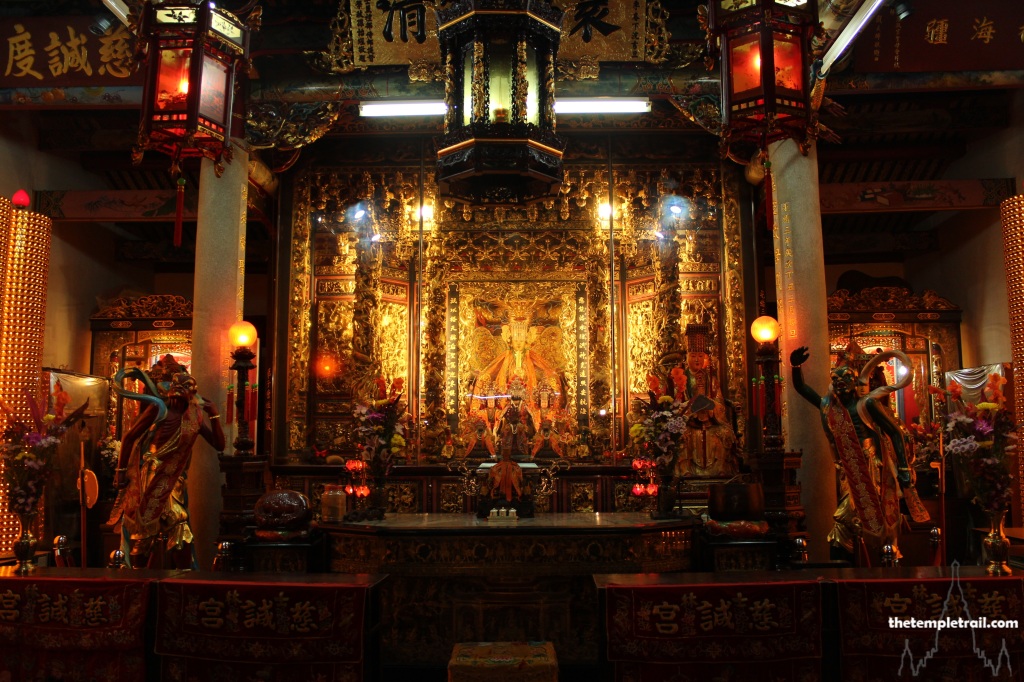
Inside the Main Hall (正殿 Zhèng Diàn), you find a dazzling array of statues. The temple seems packed to bursting with gods and as you enter, the main altar draws your attention. Before being sucked in to the central section, you detour to the left of the hall in order to inspect the altar and its gods there. The shrine on this side is home to two important Taoist figures. First is the Lord of the Way and its Virtue (道德天尊 Dàodé Tiānzūn), the Grand Pure One. Known also as the Grand Supreme Elderly Lord, he is one of the Three Pure Ones (三清 Sānqīng), the three highest gods of Taoism. Sharing the altar with The Universally Honoured Virtuous One is Laozi (老子 Lǎozǐ), mythical author of the Tao Te Ching (道德經 Dàodéjīng) and founder of Taoism in the 6th century BCE. The Chinese see Lǎozǐ as a manifestation of Dàodé Tiānzūn and venerate him as both founding teacher and holy emanation.
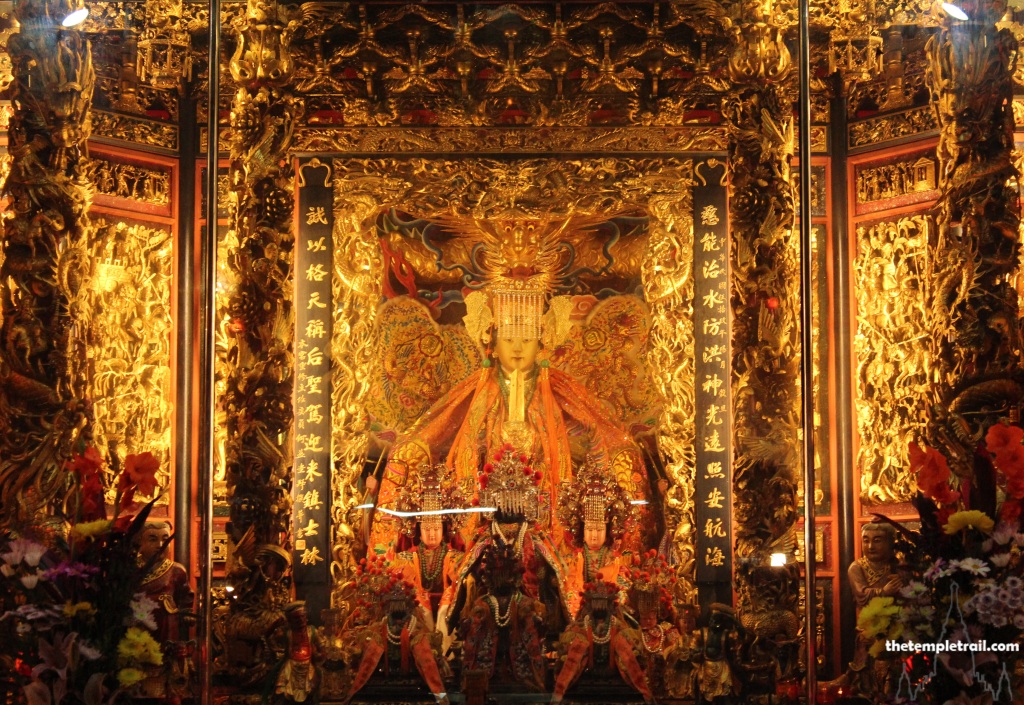
Moving from the left back to the centre, you are bombarded with golden imagery. It is here that Māzǔ holds court. Surrounded by acolytes, the sea goddess takes centre stage in her temple. Born as a mortal called Lín Mòniáng (林默孃) in 960 CE in Fujian Province, the young lady died and became a goddess aged 27 years old. Known also as the Empress of Heaven (天后 Tiān Hòu), the young lady saved her father and brother from dying in a typhoon with her magical powers. Dressed in red, she would stand by the shore and guide fishermen back safely from the seas. In 987 CE, she climbed a mountain and flew to heaven to take her place as an immortal goddess and protectress of the seas and those who traverse them. The goddess is hugely popular, not only in south China, but all over the Chinese sphere of influence.
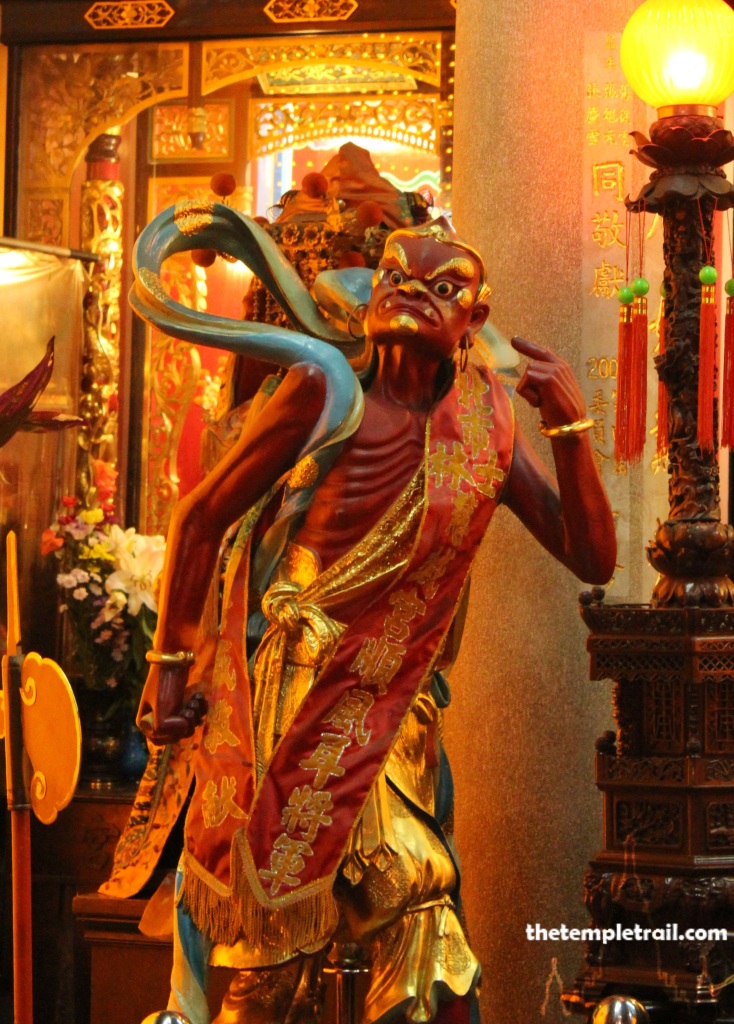
As you approach the main altar, the face of Māzǔ looks serenely out at you. In front of the altar, are two fierce looking statues. Thousand Mile Eyes (千裡眼 Qiānlǐ Yǎn) and Favourable Wind Ears (順風耳 Shùnfēng Ěr) are two demonic guardian generals who protect the goddess. Qiānlǐ Yǎn is red and his companion, Shùnfēng Ěr, is green-skinned. The two grimacing demons were defeated by Māzǔ and became her steadfast companions.
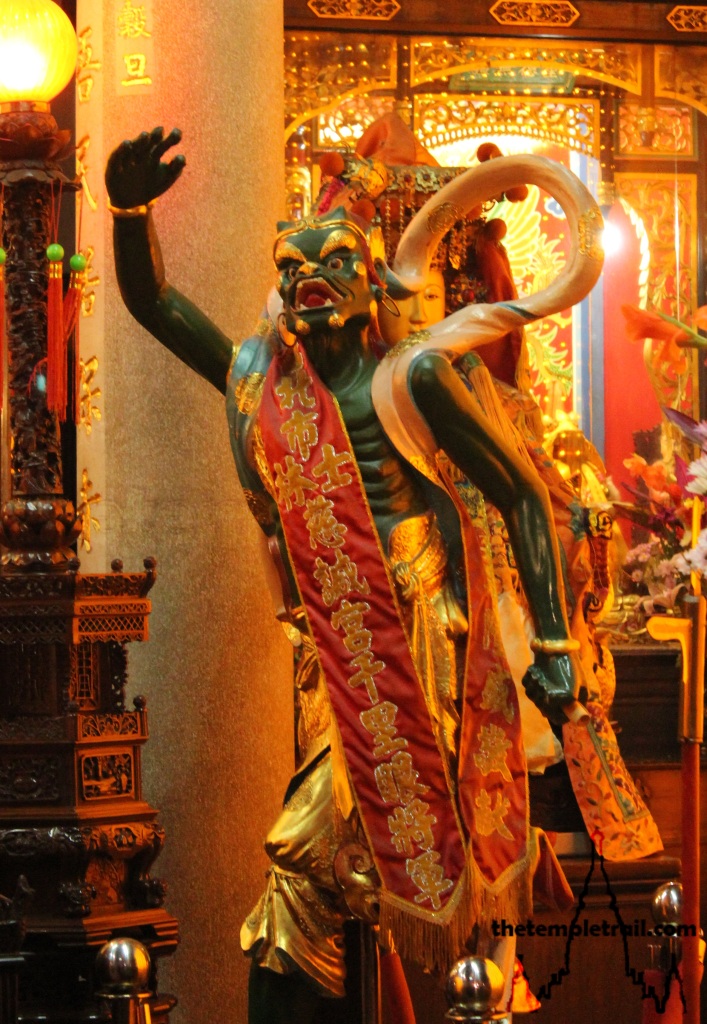
Looking at the two, you note also the statue of Nézhā (哪吒), the child god of war and the others that are placed all around the hall. As he also has the title of Marshal of the Central Altar, he is in charge of this main area of worship and its well-being. The Dragon King slaying youthful god who came to China from India flies through the skies on Wind Fire Wheels (風火輪 Fēng Huǒ Lún) brandishing the Fire-tipped Spear (火尖槍 Huǒ Jiān Qiāng) and his Heaven and Earth Ring (乾坤圈 Qián Kūn Quān). Also found in this central area is Lord Tiger (虎爷 Hǔ Yé). This figure is often found at the bottom of Taoist shrines and is a guardian deity. In Taiwan, he has a strong following and the tiger spirit is sometimes invoked to defeat spiritual enemies. Worshippers offer him meat and hell money and stamp on effigies of their enemies.
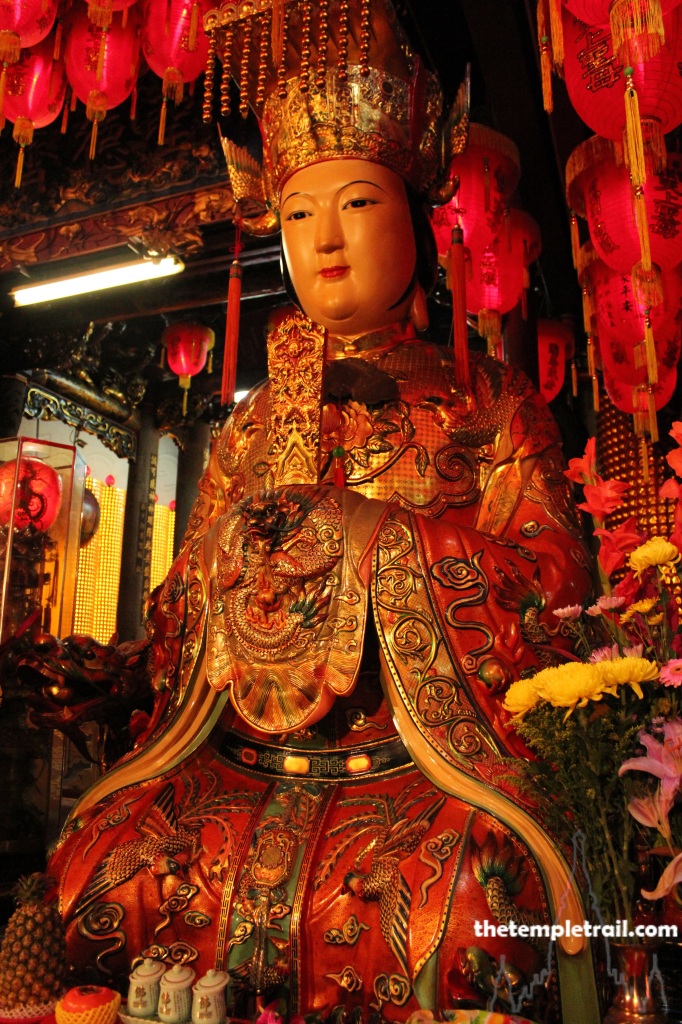
After a few more moments in the centre of the hall, you move to the altar to the right. Here, an image of the Goddess of Childbirth (注生娘娘 Zhùshēng Niáng Niang) is petitioned for children. The Maiden Who Brings Children is a fertility goddess and she is popular with young couples and parents of the recently married. Sometimes she is called the Pine Nut Maiden (松子娘娘 Sòngzǐ Niáng Niang), as pine nuts symbolise plentiful offspring.
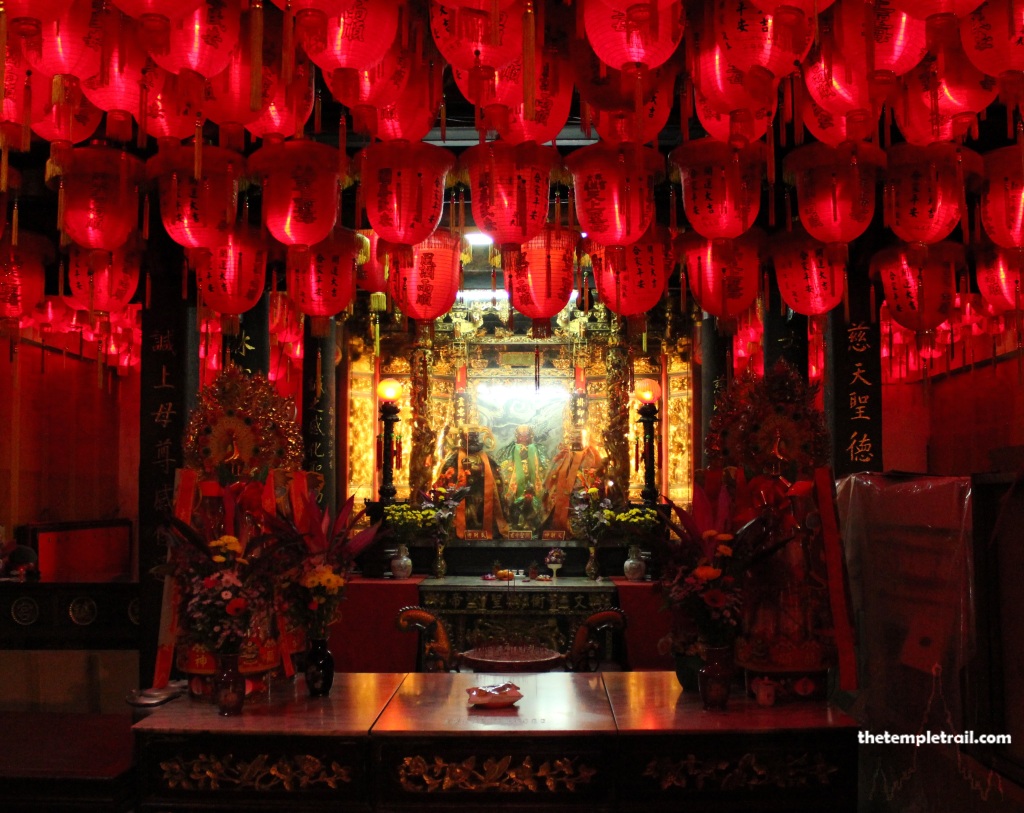
From the man hall, you move to the Left Hall to your right. The altar you encounter here is the home of Guān Yǔ (關羽) and his sworn brothers Liú Bèi (劉備) and Zhāng Fēi (張飛). The Three Kingdoms Period general is revered as a God of War and a protection deity. He symbolises loyalty, as do his two companions. Although Guān Yǔ died nearly two millennia ago, his popularity has only increased with time and the legend has grown alongside. Moving out of the smaller space, you pass an image of Guānyīn (觀音), the Goddess of Mercy. You find yourself in an open courtyard area and heading to the rear, you pass a pool with a wall moulded like a mountain with immortals and pagodas. Behind the water feature is a shrine that contains two ancient gods. Both bearded, one appearing older than the other are Chénghuáng (城隍) and Tǔ Dì Gōng (土地公). Chénghuáng is the City God. His role is to protect the city and keep a record of all of its inhabitants. Residents entreat him for the well-being of their dead ancestors. The older looking of the two figures is the white-bearded Tǔ Dì Gōng, the Earth God. He is responsible for the land and is often enshrined outside people’s houses and businesses. The two gods hold power over the domain of the city and the ground on which it stands.
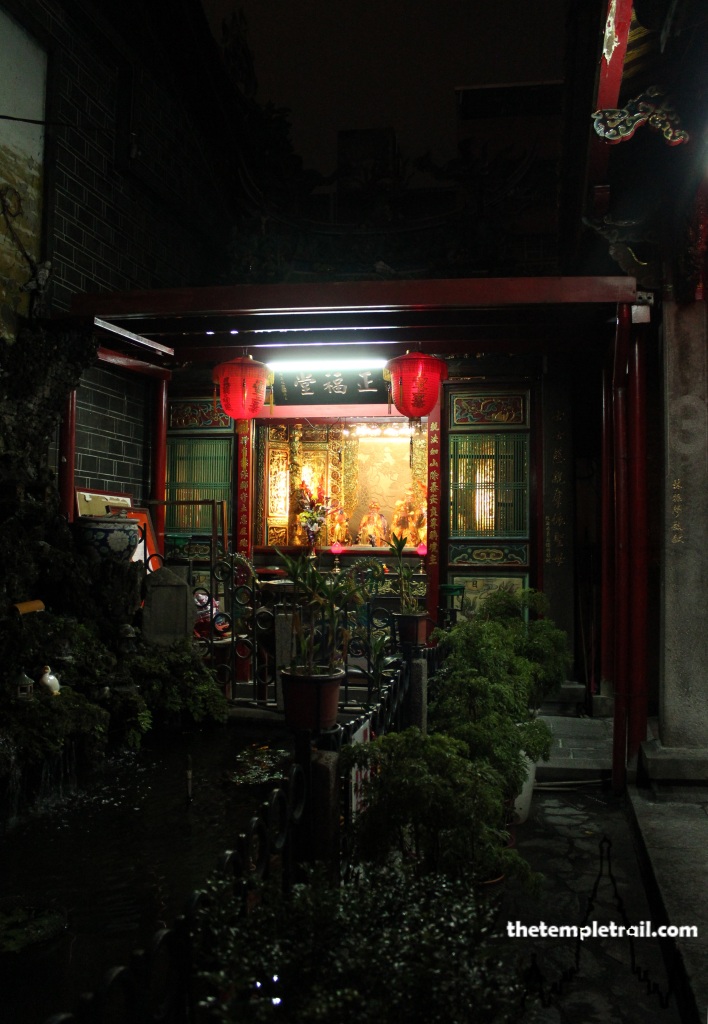
After asking them for their protection while in their territory, you leave the pair of tutelary deities and walk back down a gallery on the right of the temple. Back at the front of the temple you find a very crowded looking shrine. The various figures represent three gods who hold court in this corner of the sanctuary. In the centre of the space is Zhang Daoling (張道陵 Zhāng Dào Líng) , an Eastern Han Dynasty (25 – 220 CE) Taoist who founded the Way of the Celestial Masters sect of Taoism. Celestial Master Zhang (張天師 Zhāng Tiān Shī) is seen as the founder of religious Taoism. Before his sect, Taoists were a disparate group of mystics and healers without any central organisation. Flanking him are the Divine Farmer (神農 Shénnóng) and Imperial Lord Protector (孚佑帝君 Fú Yòu Dì Jūn). Shénnóng, a god of farming and medicine, is one of the Three Sovereigns (三皇 Sān Huáng), semi-divine mythical founding emperors of China. Fú Yòu Dì Jūn is another name for Lǚ Dòngbīn (呂洞賓), one of the Eight Immortals (八仙 Bāxiān). The Tang Dynasty scholar is seen as the leader of the Eight Immortals and a dispeller of evil.
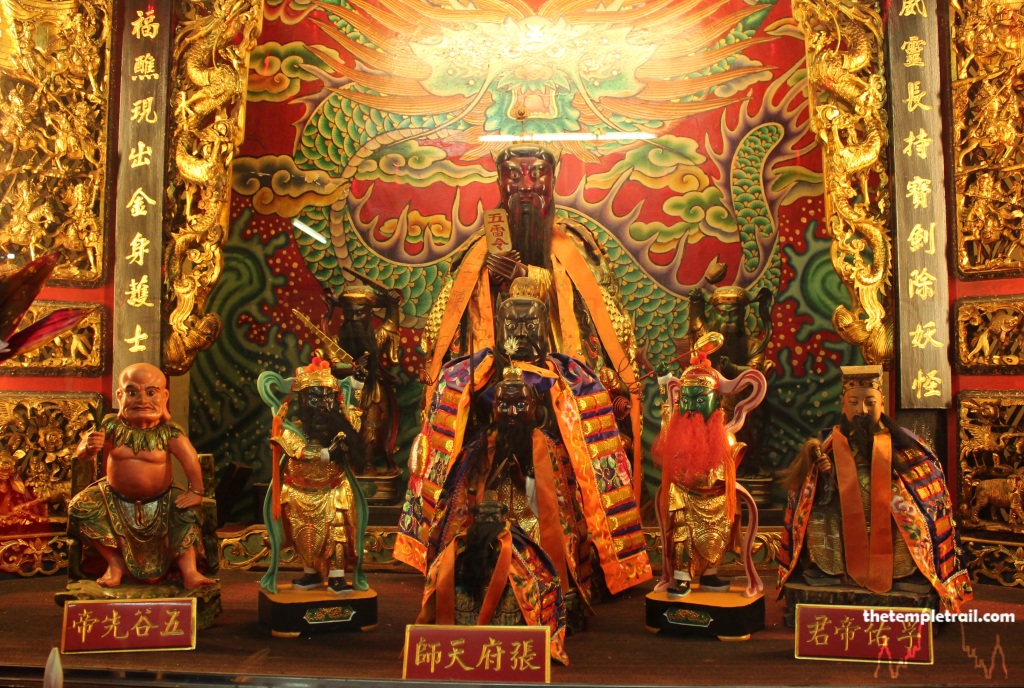
Following your trail back through the Main Hall, you enter into the Right Hall. The structure mirrors the opposite side you have just come from, but in the altar different deities are enshrined. The first of the trio is Wénchāng Dìjūn (文昌帝君), the God of Culture and Literature. Also known as Wénchāng Wáng (文昌王), he is honoured by scholars, students and their parents in the hope that he can aid them in their studies. Next to him is Kuí Xīng (魁星), the god of examinations. The impish figure of Great Kui the Star Prince is associated with the spoon of the big dipper constellation and is worshipped for exam success. He was particularly responsible for the students who took the Imperial Examinations (科舉 Kējǔ) in the past. also sharing the altar space is the King of Giving Abundant Blessings (廣澤尊王 Guǎng Zé Zūn Wáng), a Hokkien ancestral god of Fujian. Popular with overseas Chinese, he is protector of the Nan’an community. The triumvirate represent the desire for success of the Fujian natives who settled in Taipei so long ago.
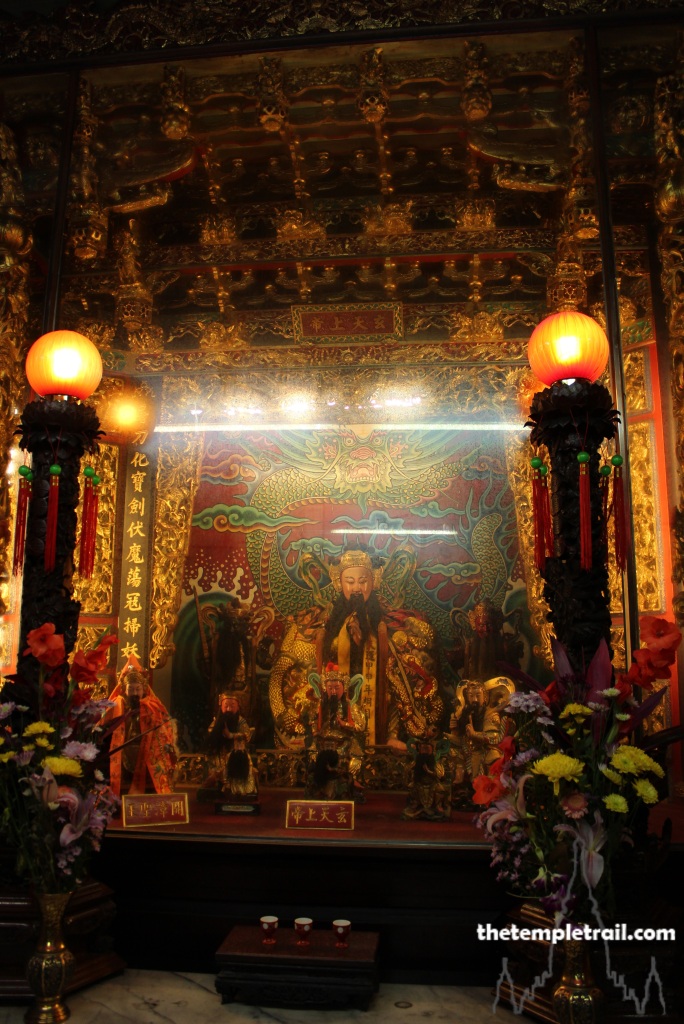
Walking out into another courtyard area, you see at the back a shrine to Kṣitigarbha, the Buddhist bodhisattva of hell. He is entreated to help ancestors attain realization and enter into nirvana. At the front of this side of the temple is a shrine to the Mysterious Heavenly Highest Emperor (玄天上帝 Xuán Tiān Shàng Dì). Known by many names, including the Northern Emperor (北帝 Běidì) and the Mysterious Warrior (玄武 Xuán Wǔ), he is a powerful god worshipped all over China. The northern deity is a guardian god who fights against sorcery and is the patron of martial artists. Next to the Mysterious Warrior, is the Sacred King, Founder of Zhangzhou (開漳聖王 Kāi Zhāng Shèng Wáng) , first governor of Zhangzhou in Fujian Province. The Tang Dynasty general is respected by the Hokkien as a revered ancestor.
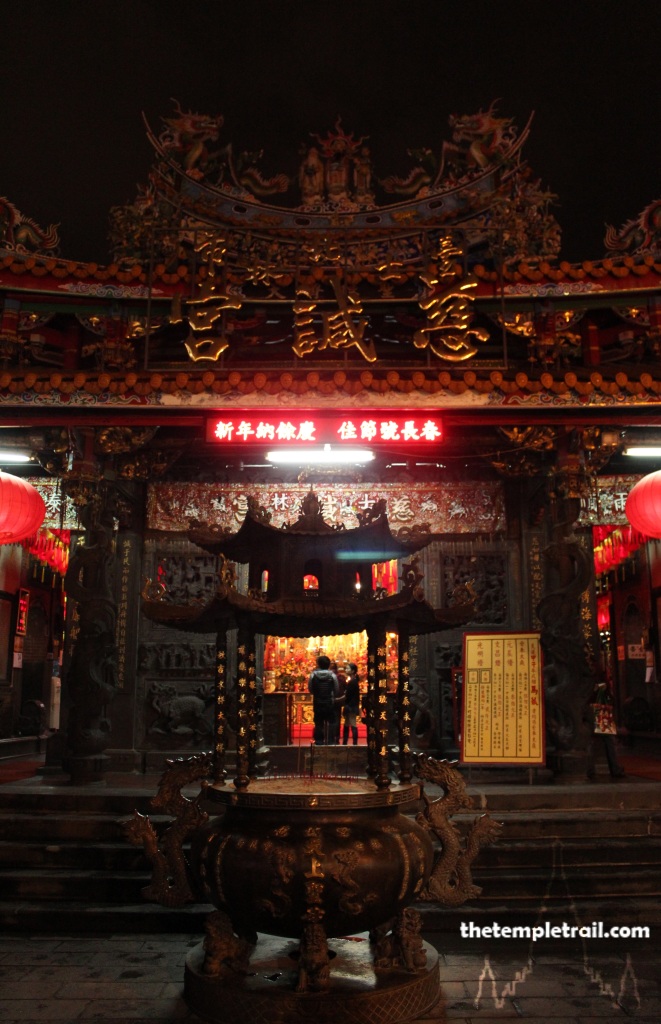
The moody light of the temple at night has burned itself on your memory. The mysterious feel of the exotic building will linger on long after you have left Taipei. The red glow of lanterns gives the area an ethereal aura. Stepping out of the chambers, you go back out into the front courtyard. Looking back, the dark exterior is like a void in the brightly light market streets. Heading back into the neon playground of Shilin, you are glad for the respite you took among the gods in the old section of the district. Feeling rested, you can now continue your feasting with the mortals of Taipei.
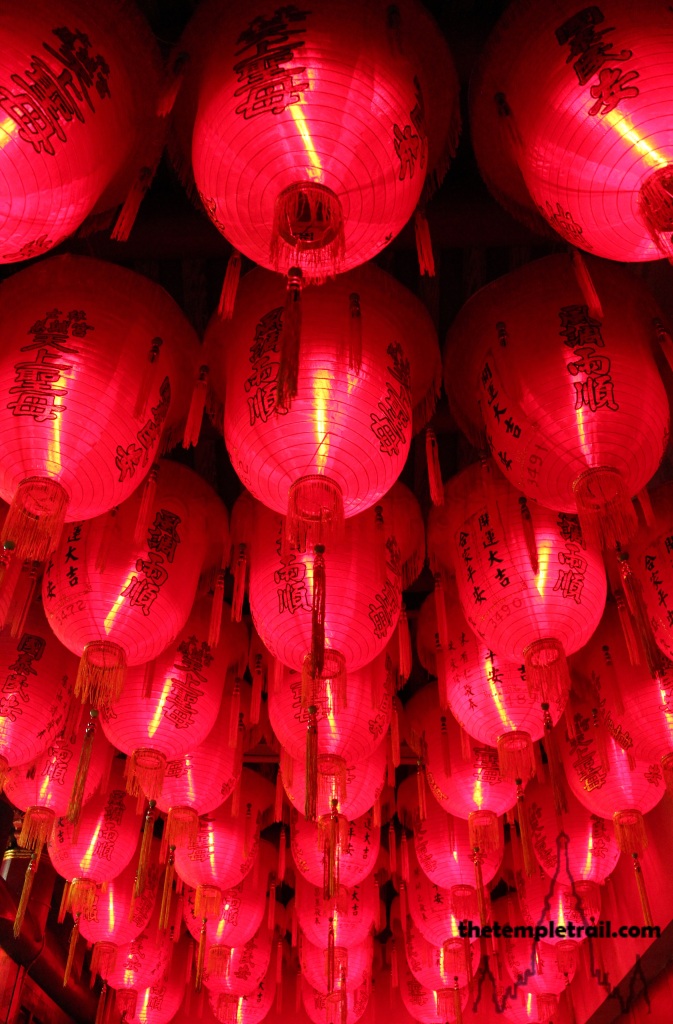
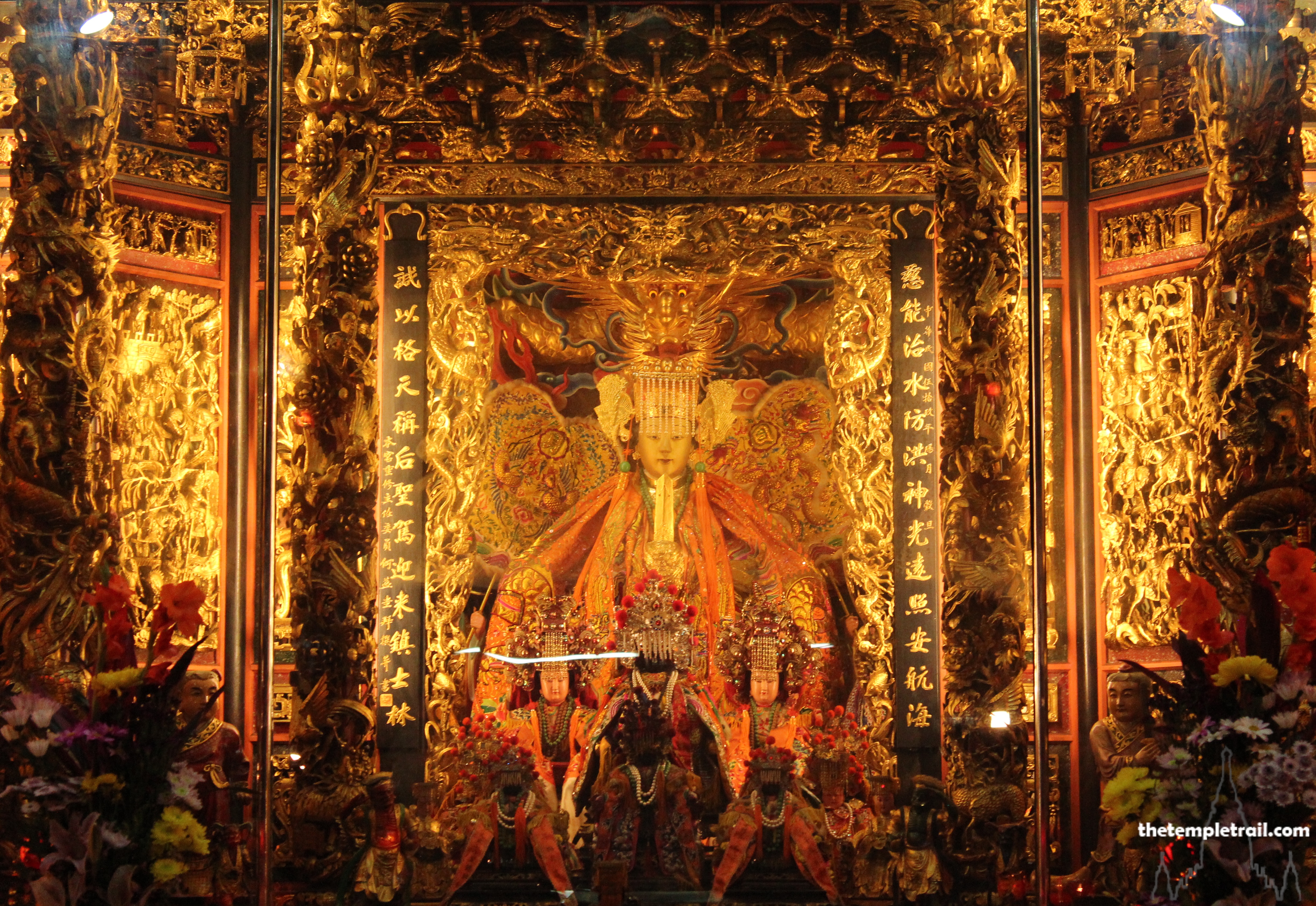
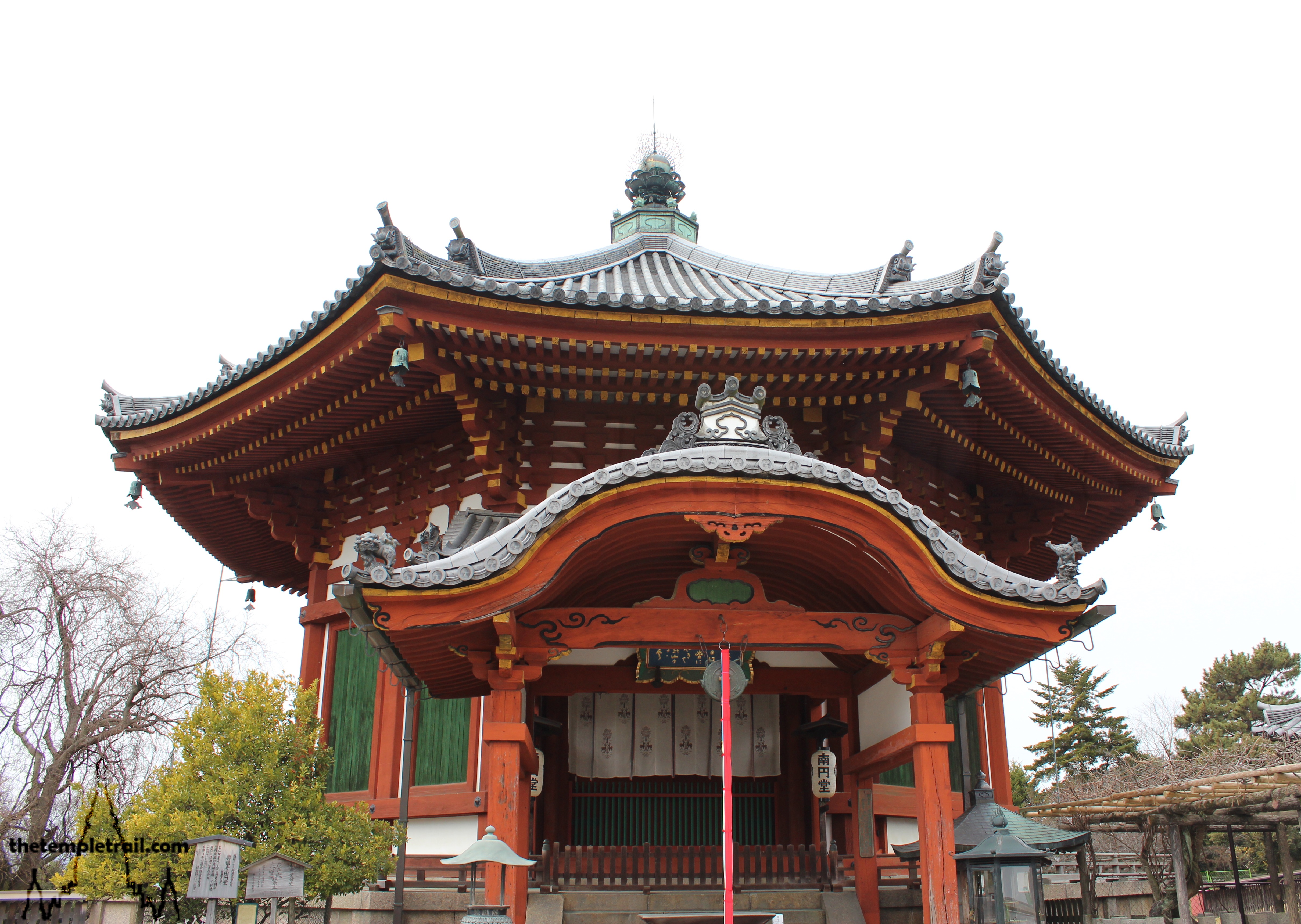 Kōfuku-ji
Kōfuku-ji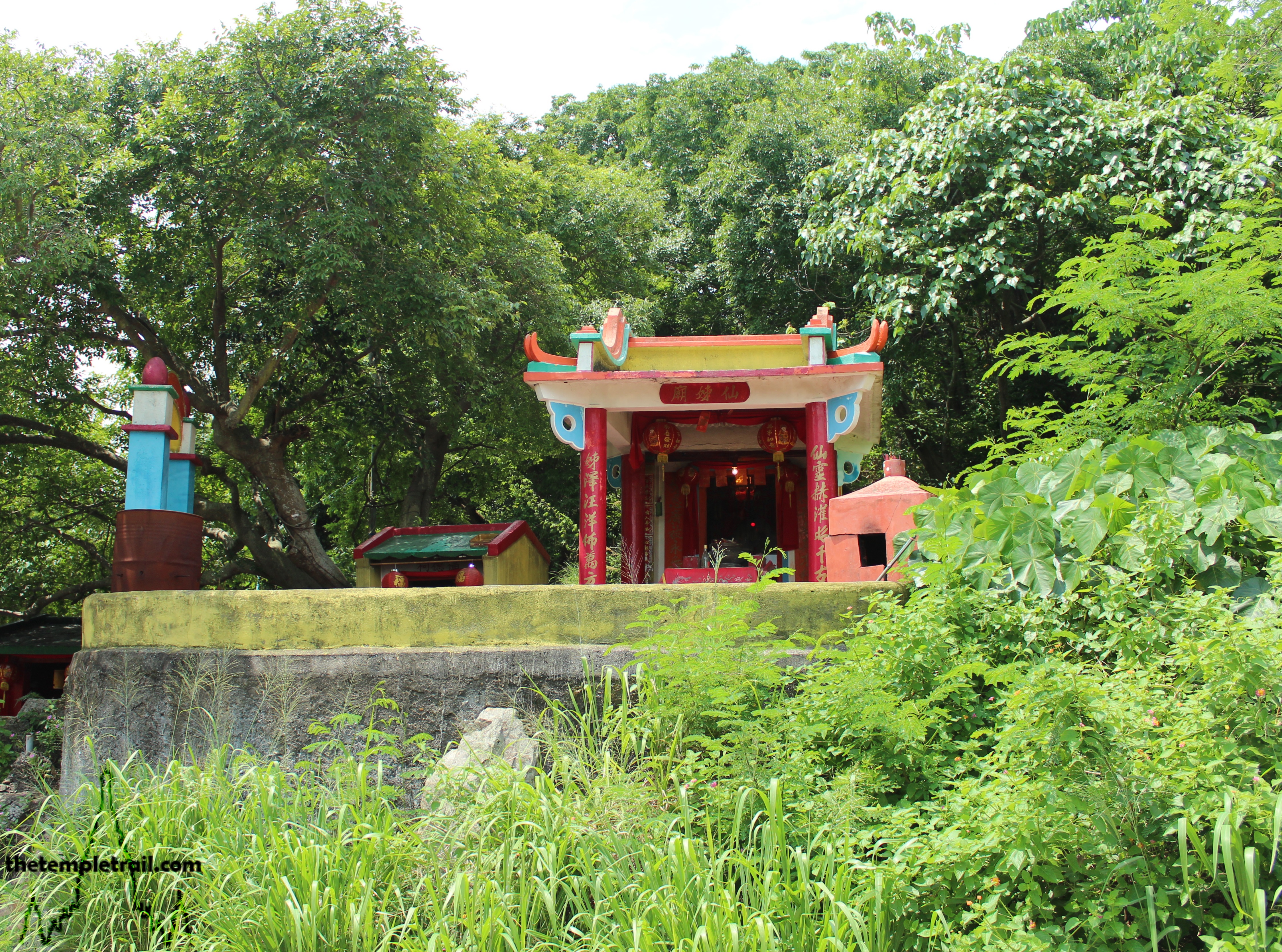
[…] we’ll wander through Shihlin Market area for snacks, etc, esp if it’s hot. Then on to Shilin Cixian Temple, dedicated to Matzu. Finally, ending up at Shihlin near Christ the King church on Wenlin Road, just […]